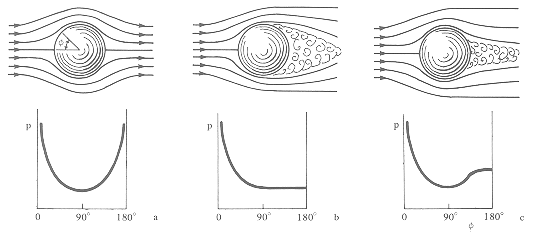| |
The diagrams
below illustrate three flow situations and the associated pressure distribution
on the sphere. In (a) the fluid is inviscid, and no viscous boundary
layer exists. The flow is symmetrical about f
= 900 and the pressure distribution on the front and
back of the sphere is the same. No net pressure force exists and the sphere
exhibits no drag.
In (b) viscosity has been included and the flow over
the sphere is laminar up to the point of separation. A turbulent wake behind
the sphere alters the pressure distribution, with pressures on the front
of the sphere being larger than those at the back. The pressure force is now
a major contribution to the drag.
In (c) the Reynolds number is high
enough that the flow has become turbulent before reaching f = 900. The turbulent flow stays attached onto
the rear surface before finally separating to yield a smaller turbulent wake.
Some pressure recovery occurs on the back of the sphere and reduces the pressure
drag. This term more than compensates for the increased viscous drag
of the turbulent flow. |
|
